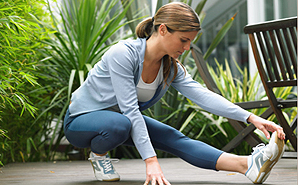
Image: Michael Blann | Digital Vision | Thinkstock
Ever get ‘sore’ days after you’ve exercised? Delayed Onset Muscle Soreness. D.O.M.S. It’s actually a verifiable phenomena in the exercise and sporting world. Just ask any athlete (or maybe you were once a competitive athlete yourself). For some strange reason when you push your body (and your muscles) to a new level, increase your intensity, increase the amount lifted, increase your distance, etc. delayed soreness ensues. Anything that would ‘increase’ your level of play from the previous seems to always cause a ‘soreness’ or ‘ache’ in those muscle groups involved. This soreness unfortunately usually doesn’t show up until 48 hours later (sometimes 36 hours).
I’ve read the proposed explanations, and the science behind it. I’ve talked with fellow colleagues. I’ve even chatted with the collegiate athletes. There doesn’t seem to be much rhyme or reason to DOMS. It’s here to stay. The science tends to believe lactic acid build up after anaerobic cellular activity is a big contributor, but it’s never been proven. We may never be able to explain the cause, but there are some things about DOMS that we do know.
Factors that can cause (contribute to) episodes of DOMS
Improper warm up or cool down (or the absence of them)
These two actions will cause DOMS. This has nothing to do with your level of activity. I honestly think it has a lot to do with that lactic acid presence. Take 5 minutes before and after your workout to get things ‘ironed out’.
Eccentric movement of any exercise
This is the ‘lowering’ phase of any movement, or when the angle of the joint involved is increasing. This also happens to be the ‘downhill’ phase of running. It seems that running up hill does not cause as much DOMS as running, jogging or the deceleration when going downhill. Just something to keep in mind.
Lack of flexibility
This ties in with the first factor. A warm and flexible muscle (or muscle groups) is a happy muscle. A ‘cooled down’ muscle gets a chance to flush out as much lactic acid as possible. DOMS occurs when you have successfully ‘upset’ something (yes, a very loose description – but it works)
In the end DOMS is almost a normal and expected result of exercising. Whatever you do, don’t take DOMS lying down! Most people when they get that “I feel like I got run over by a train” feeling after a prior hard bout of exercising want to just be immobile and ‘rest’. They think taking time off from exercising is the best thing they could do, when it’s the worst. The soreness and ache will only be relieved by getting back up and out there. You don’t have to go out and kill yourself, but the exercise will increase the blood flow to the muscles, flush out the lactic acid build up, and probably increase your flexibility.
Active recovery of your muscles is easier on your body, and can rid you of the DOMS that can last for days if you just ‘lie around’. Stay active and don’t be deterred by the DOMS!
Best of luck!

















